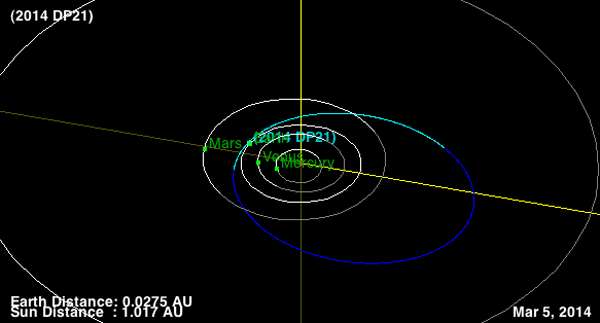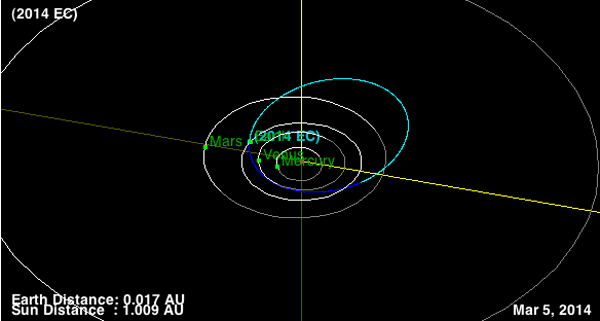.

This image shows the relative locations of asteroid 2014 DX110 and Earth on March 4, 2014.
.
As happens about 20 times a year with current detection capabilities, a known asteroid will safely pass Earth Wednesday closer than the distance from Earth to the moon.
This asteroid, 2014 DX110, is estimated to be about 100 feet (30 meters) across. Its closest approach to Earth will be at about 217,000 miles (about 350,000 kilometers) from Earth at about 1 p.m. PST (4 p.m. EST) on March 5. The average distance between Earth and its moon is about 239,000 miles (385,000 kilometers).
NASA detects, tracks and characterizes asteroids and comets using both ground- and space-based telescopes. The Near-Earth Object Observations Program, commonly called "Spaceguard," discovers these objects, characterizes a subset of them and identifies their close approaches to determine if any could be potentially hazardous to our planet.
NASA's Jet Propulsion Laboratory, Pasadena, Calif., manages the Near-Earth Object Program Office for NASA's Science Mission Directorate in Washington. JPL is a division of the California Institute of Technology in Pasadena.
Quelle: NASA
.

.

.
The Asteroid Watch Widget tracks asteroids and comets that will make relatively close approaches to Earth. The Widget displays the date of closest approach, approximate object diameter, relative size and distance from Earth for each encounter. The object's name is displayed by hovering over its encounter date. Clicking on the encounter date will display a Web page with details about that object.
The Widget displays the next five Earth approaches to within 4.6 million miles (7.5 million kilometers or 19.5 times the distance to the moon); an object larger than about 150 meters that can approach the Earth to within this distance is termed a potentially hazardous object.
,

.

.

.

.

.

Quelle: NASA
.
Close Approach Of Asteroid 2014 DX110
Taken by Ernesto Guido, Nick Howes & Martino Nicolini on March 5, 2014
Taken by Ernesto Guido, Nick Howes & Martino Nicolini on March 5, 2014

Quelle: Spaceweather
5614 Views
